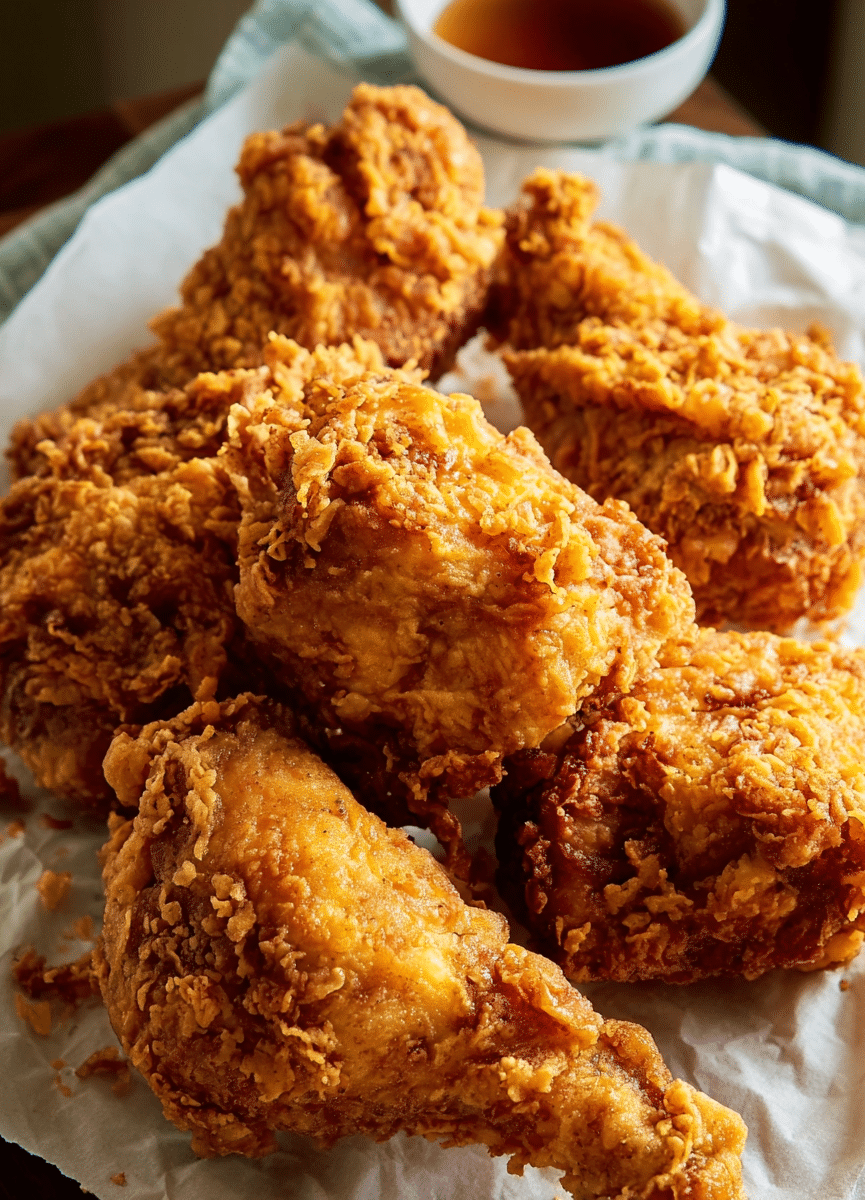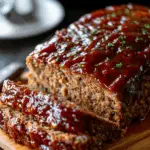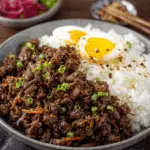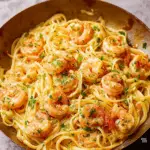This Crispy Fried Chicken recipe is the ultimate comfort food. With its golden, ultra-crispy crust and juicy, flavorful meat, it rivals your favorite fried chicken spot. A tangy buttermilk brine tenderizes the chicken and adds depth of flavor, while a seasoned flour coating ensures a crunchy bite. Whether you’re cooking for a family meal or a weekend indulgence, this foolproof method guarantees crowd-pleasing results.
Ingredients
For the Brine:
-
8 pieces bone-in, skin-on chicken (thighs, drumsticks, and breasts)
-
2 cups buttermilk
-
2 tablespoons fine sea salt
-
1 tablespoon honey
-
2 teaspoons garlic powder
-
1 teaspoon onion powder
-
1 teaspoon paprika
-
½ teaspoon cayenne pepper (optional)
For the Dredge:
-
2 cups all-purpose flour
-
½ cup cornstarch
-
1 tablespoon baking powder
-
2 teaspoons salt
-
2 teaspoons garlic powder
-
2 teaspoons onion powder
-
2 teaspoons paprika
-
1 teaspoon black pepper
-
1 teaspoon dried herbs (thyme, oregano, or mixed herbs)
For Frying:
-
3–4 cups neutral oil with a high smoke point (peanut, vegetable, or canola oil)
Directions
-
Prepare the Brine:
In a large bowl, whisk together the buttermilk, sea salt, honey, garlic powder, onion powder, paprika, and cayenne pepper. Submerge the chicken pieces fully in the mixture. Cover and refrigerate for at least 2 hours or overnight for the best flavor and tenderness. -
Make the Dredge:
In a separate bowl, mix the flour, cornstarch, baking powder, salt, garlic powder, onion powder, paprika, black pepper, and herbs. This will be your crispy coating. -
Coat the Chicken:
Remove chicken from the brine and let excess liquid drip off. Dredge each piece in the flour mixture, pressing to coat thoroughly. For an extra-crispy crust, dip the floured chicken briefly back into the brine, then dredge once more. -
Heat the Oil:
In a deep skillet or Dutch oven, heat oil to 350°F (175°C). Use a thermometer to monitor the temperature for even cooking. -
Fry the Chicken:
Carefully place chicken pieces into the hot oil without overcrowding. Fry in batches if necessary. Cook for 10–12 minutes per side, until golden brown and internal temperature reaches 165°F (74°C). -
Drain and Serve:
Remove chicken and place on a wire rack over a baking sheet to drain. Let rest for a few minutes before serving.
Nutritional Information (Per Serving)
-
Calories: ~520 kcal
-
Protein: 31 g
-
Fat: 37 g
-
Carbohydrates: 17 g
-
Sodium: 550 mg
-
Cholesterol: 95 mg
-
Saturated Fat: 7 g
-
Sugars: 4 g
The Science Behind Perfectly Crispy Chicken
Creating great fried chicken is more than just dunking meat in oil—it’s a balance of technique, temperature, and timing.
1. The Brine:
Brining the chicken in buttermilk and spices does more than infuse flavor. The acidic nature of buttermilk helps tenderize the meat, breaking down protein structures to ensure every bite is juicy and succulent. Salt in the brine also plays a crucial role, helping the meat retain moisture while seasoning it from the inside out.
2. The Dredge:
The outer coating is where the magic happens. The combination of flour and cornstarch is a well-known trick for achieving that signature crunch. Cornstarch has a higher starch content and less gluten than flour, resulting in a crispier, lighter coating. Baking powder introduces tiny air pockets, creating more texture and volume in the crust.
3. The Double Dredge Technique:
Dipping the chicken in the brine and then the seasoned flour mixture twice is a professional trick used by restaurants to create an ultra-crispy crust. The first layer clings to the moisture on the chicken. Reintroducing the chicken to the brine briefly allows for another coating of flour to adhere, creating that extra-thick, craggy texture that crunch lovers dream of.
4. The Frying Process:
Frying at the right temperature (around 350°F or 175°C) is essential. Too low, and the chicken absorbs too much oil and turns greasy. Too high, and the crust burns before the interior cooks through. A kitchen thermometer is the most reliable tool here. Frying in small batches prevents the oil temperature from dropping too dramatically and ensures even cooking.
5. Resting the Chicken:
After frying, the chicken should rest on a wire rack—not paper towels. The airflow underneath helps maintain the crispy crust and allows excess oil to drain away without making the bottom soggy.
Flavor Profiles and Customizations
One of the greatest strengths of this fried chicken recipe is its versatility. The spice blend used in both the brine and the dredge creates a balanced, savory flavor, but you can customize it to suit your palate:
-
For a spicy version, add more cayenne pepper or hot sauce to the brine and a pinch of chili powder or smoked paprika to the dredge.
-
For an herby variation, fresh chopped rosemary, sage, or tarragon can be added to the dredge for a more aromatic crust.
-
For global fusion, consider using curry powder for an Indian twist, five-spice powder for a Chinese variation, or turmeric and garlic for a Middle Eastern influence.
Don’t be afraid to experiment. Fried chicken is surprisingly adaptable, and with just a few tweaks, you can make it your own signature dish.
What to Serve With Fried Chicken
Fried chicken is hearty and flavorful, which means it pairs beautifully with a wide variety of side dishes. Here are some classic and contemporary options to consider:
-
Classic Southern sides: Buttermilk biscuits, mashed potatoes with gravy, collard greens, and mac and cheese.
-
Light and fresh options: Coleslaw, cucumber salad, or pickled vegetables to balance out the richness.
-
Sweet contrasts: Cornbread, waffles with maple syrup (for chicken and waffles), or a drizzle of honey right over the chicken.
For beverages, iced tea, lemonade, or a crisp lager beer all complement the savory crunch perfectly.
Tips for Success
Even if you’re new to frying, this recipe is very approachable. Here are a few practical tips to help ensure the best results:
-
Marinate overnight whenever possible. The longer the brine time, the deeper the flavor and juicier the meat.
-
Use a deep, heavy-bottomed skillet or Dutch oven to maintain stable frying temperatures.
-
Keep the coating dry until just before frying. Moisture can cause the flour to clump prematurely.
-
Don’t overcrowd the pan—it lowers the oil temperature and results in uneven cooking.
-
Let it rest before serving—this lets the juices redistribute and ensures crispiness.
Why Homemade is Best
While it’s tempting to pick up fried chicken from a local fast-food joint or deli, homemade versions offer several key advantages:
-
Control over ingredients: You can avoid unnecessary additives or preservatives and use high-quality meat and oil.
-
Tailored flavors: Customize the brine and dredge to your exact taste preferences.
-
Better texture: Freshly fried chicken has a crispness that takeout often loses during transport.
-
Satisfaction: There’s a genuine sense of pride in mastering this iconic dish.
Moreover, making fried chicken at home is a great way to bring people together. Whether you’re hosting a Sunday dinner or a summer cookout, fried chicken never fails to bring smiles to the table.
Conclusion
Crispy fried chicken is more than just a meal—it’s a celebration of flavor, technique, and culinary tradition. From its storied history to its deeply satisfying texture and flavor, it continues to capture the hearts (and appetites) of food lovers around the world.
This recipe brings together time-tested methods and modern tips to help you recreate restaurant-quality fried chicken in your own kitchen. With its buttermilk brine, spiced double






